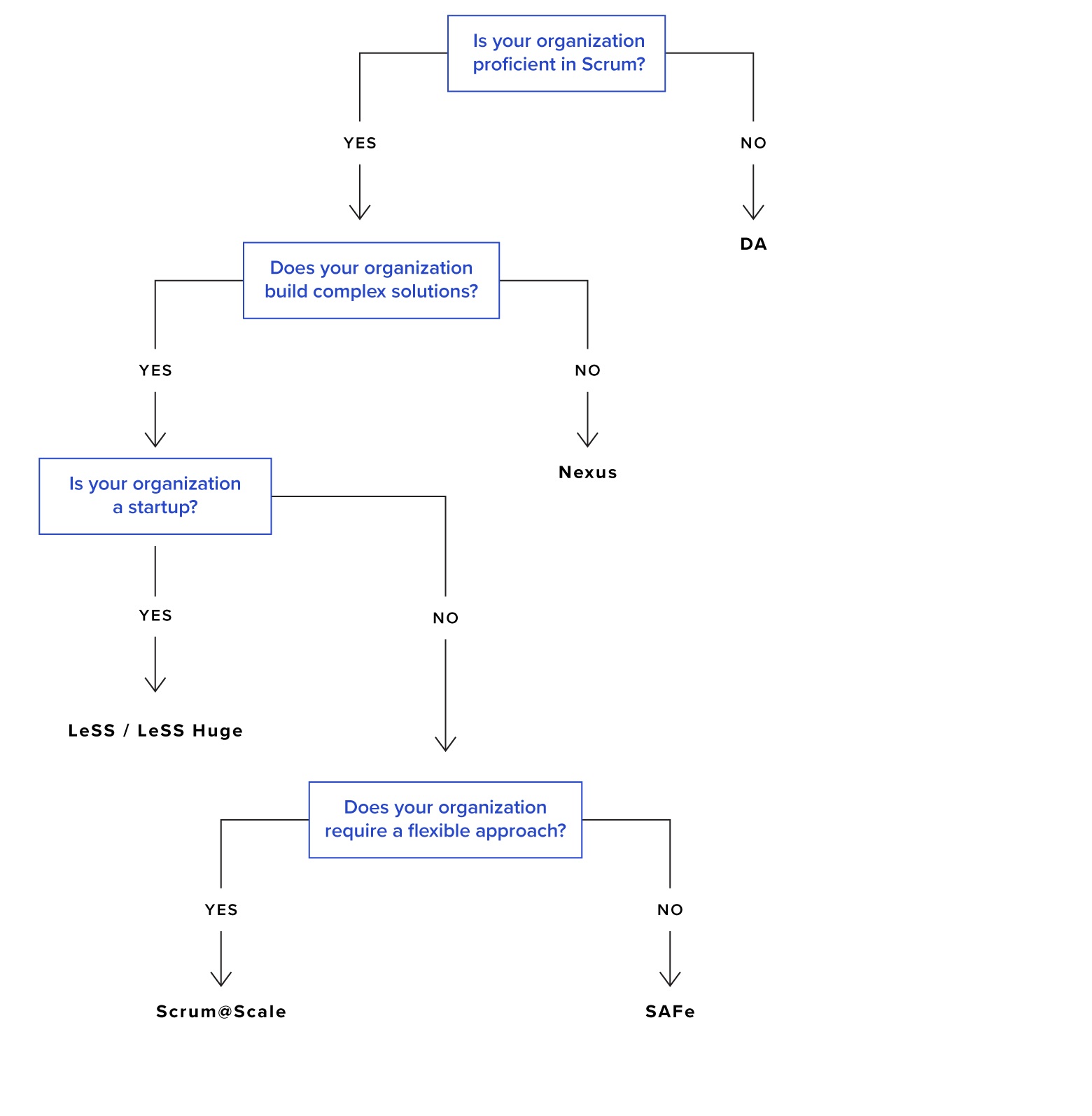Working in small increments with a small team is how any good digital product comes to life. As your business grows, so does your product backlog. You now need to bring in additional team members and even maybe create additional teams. Sounds familiar?
Scaling agile processes can be a crucial step in the growth and development of any digital product. However, determining the right time to scale can be a challenge. In this article, we will explore the signs that indicate your team is ready for scaling and the factors you should consider before taking this leap.

Determining the Right Time to Scale
Scaling agile requires careful consideration and assessment of your team's capabilities and product needs. It's important to look for signs that indicate your team is ready for scaling. By recognizing these signs, you can ensure a smooth transition and maximize the benefits of scaling.
Before we go into the details of identifying if your team is ready to scale let’s identify if your product requires scaling processes.
Let’s now talk about identifying signs that your team is ready to scale. There isn’t any point scaling up if your team isn’t ready for it.
Signs that Your Team is Ready for Scaling
There are several indicators that suggest your team is ready for scaling. These signs include:
1. Consistent delivery of quality work
Consistency is key when it comes to scaling. If your team consistently delivers high-quality work, it demonstrates their ability to handle increased demands and complexity.
2. Demonstrated agility and adaptability
Agility and adaptability are essential qualities for a team that is ready to scale. If your team has shown the ability to quickly respond to changes and adapt their approach, it's a positive sign that they are prepared for scaling.
3. Ability to handle complex projects and dependencies
Complex projects and dependencies require a higher level of coordination and collaboration. If your team has successfully handled such projects in the past, it indicates their readiness for scaling.
4. Achievement of team goals and objectives
When your team consistently achieves their goals and objectives, it demonstrates their ability to work effectively and efficiently. This achievement is a positive sign that your team is ready to take on larger challenges through scaling.
If your team exhibits these signs, it's a good indication that you are ready to explore scaling options. However, before embarking on this journey, there are several important factors that need to be considered.
Factors to Consider Before Scaling Your Agile Process
Scaling your agile process requires careful planning and consideration. Here are some factors to keep in mind:
- Organizational readiness: Ensure that your organization as a whole is prepared to embrace scaling and support the necessary changes.Scaling is not just about the team; it involves the entire organization. It's crucial to assess if your organization is ready to embrace the changes that come with scaling and if it has the necessary support structures in place.
- Team dynamics: Assess your team's structure, communication channels, and ability to collaborate effectively.Effective team dynamics are vital for successful scaling. Evaluate your team's structure, communication channels, and their ability to collaborate seamlessly. Identifying any areas that need improvement will help ensure a smooth scaling process.
- Resource availability: Evaluate the availability of skilled resources and assess if additional resources will be required.Scaling often requires additional resources. Evaluate the availability of skilled resources within your organization and determine if additional resources will be needed to support the scaling process. This assessment will help you plan for any resource gaps that may arise.
- Culture and mindset: Consider the existing culture and mindset within your organization and how it aligns with agile practices and principles.The culture and mindset within your organization play a significant role in the success of scaling. Consider if your organization's culture aligns with agile practices and principles. If there are any gaps, it's essential to address them before scaling to ensure a smooth transition.
- Process maturity: Assess the maturity level of your current agile process and identify any areas that need improvement before scaling.
Before scaling, it's crucial to assess the maturity level of your current agile process. Identify any areas that need improvement and address them to ensure a solid foundation for scaling. This assessment will help you identify potential challenges and mitigate them proactively.
It's essential to thoroughly evaluate these factors and ensure that your team is prepared for scaling before proceeding with any specific framework. Taking the time to assess readiness and address any gaps will set your team up for success as you embark on the journey of scaling your agile process.
Enjoying this article? Don't miss out on more exclusive insights and real-life digital product stories at LeadReads. Read by Top C Execs. Join here.
Navigating the World of Scaling Frameworks
Exploring Different Scaling Frameworks for Agile
Here, we will take a closer look at some of the most widely used scaling frameworks:
- Scrum of Scrums: This framework focuses on coordination and communication between multiple Scrum teams working on a large-scale project. It establishes a platform for teams to share information, resolve dependencies, and align their efforts towards a common goal. By implementing regular meetings between representatives from each team, the Scrum of Scrums framework enables effective collaboration and ensures that the project stays on track.
- Scaled Agile Framework (SAFe): SAFe provides a comprehensive framework for scaling agile across the entire organization and is widely adopted by many enterprises. It offers a structured approach to scaling agile practices, emphasizing alignment, collaboration, and continuous improvement. SAFe provides a set of principles, practices, and roles that help organizations scale agile in a systematic and sustainable manner.
- Large-Scale Scrum (LeSS): LeSS emphasizes simplicity and provides guidelines for scaling the Scrum framework for bigger projects. It focuses on scaling agile practices while keeping the core principles of Scrum intact. LeSS encourages organizations to adopt a minimalist approach, reducing unnecessary complexity and promoting transparency and collaboration among teams.
Each of these scaling frameworks has its own unique characteristics and benefits.
A Comparison of Popular Scaling Frameworks
Comparing scaling frameworks can help you make an informed decision about which one is the best fit for your organization. Here are some key factors to consider when evaluating different scaling frameworks:
- Adaptability to your organization's specific needs: Different organizations have different requirements and constraints. It's crucial to choose a scaling framework that can be tailored to fit your organization's unique context and goals.
- Support for distributed teams and remote work: With the rise of remote work and distributed teams, it's essential to select a scaling framework that provides guidelines and practices to effectively manage and coordinate teams that are geographically dispersed.
- Integration with existing agile practices: If your organization has already adopted agile practices, it's important to consider how well a scaling framework integrates with your existing processes. Seamless integration can help minimize disruption and ensure a smooth transition to the scaled agile environment.
- Availability of training and certification programs: Training and certification programs can play a vital role in enabling successful adoption of a scaling framework. Consider the availability of training resources and certification programs to ensure that your teams have the necessary knowledge and skills to implement the chosen framework effectively.
- Community support and resources: The availability of a vibrant community and ample resources can greatly facilitate the adoption and implementation of a scaling framework. Consider the level of community support, including forums, user groups, and online resources, to ensure that you have access to a wealth of knowledge and guidance.
By carefully considering these factors, you can select the scaling framework that aligns best with your organization's goals and requirements. Remember, the choice of a scaling framework is not a one-size-fits-all decision. It should be based on a thorough understanding of your organization's needs and a clear vision of how you want to scale your agile practices.
To make this decision slightly easier, I’ve created a small flowchart to help you decide. This flowchart is a bird’s eye view of how to decide; a more nuanced decision-making framework should be employed given the constraints you are under.

Taking a Closer Look at Scaling Agile
Now that we have explored some of the scaling frameworks, let's delve into a few specific ones to gain a deeper understanding of their key features and benefits.

Understanding the Scaled Agile Framework (SAFe)
The Scaled Agile Framework, commonly known as SAFe, is one of the most widely adopted scaling frameworks. SAFe provides organizations with a comprehensive approach to scaling agile practices across teams, departments, and the entire enterprise. It offers guidance on portfolio management, agile architecture, and coordination between large numbers of teams working on complex projects.
Demystifying Nexus: A Scaling Framework for Scrum
Nexus is a framework specifically designed for scaling Scrum. It provides guidelines and practices for overcoming the challenges that arise when multiple Scrum teams collaborate on a single product. Nexus emphasizes cross-team collaboration, synchronization, and integration to ensure seamless delivery of the product.
Large-Scale Scrum (LeSS): Scaling Agile for Big Projects
Large-Scale Scrum (LeSS) is an approach that focuses on simplicity and scaling the Scrum framework for large-scale projects. LeSS promotes the idea of one Product Owner and one Product Backlog for the entire product, enabling teams to work together more efficiently and effectively. It emphasizes the importance of self-organizing teams and transparency.
Scrum@Scale: Scaling Scrum Across the Organization
Scrum@Scale is a lightweight framework that provides a modular approach to scaling Scrum across the organization. It enables organizations to deploy Scrum consistently at all levels, from individual teams to the entire enterprise. Scrum@Scale emphasizes a "minimum viable bureaucracy" approach, allowing organizations to tailor the framework to their specific needs.
An Introduction to Disciplined Agile (DA) for Scaling Agile
Disciplined Agile (DA) is a process decision framework that provides guidance on scaling agile practices by considering the unique context of each organization. DA allows organizations to choose the combination of agile and lean practices that work best for them. It emphasizes flexibility and tailoring to suit the organization's specific needs.
Scaling Agile: Proceed with Caution
Scaling agile can bring numerous benefits to your organization, but it is not without its challenges. To ensure a successful scaling initiative, it's important to follow some best practices and consider key factors before making any decisions.
Best Practices for Scaling Agile Teams
Here are some best practices to follow when scaling agile teams:
- Start small and iterate: Begin with a pilot project or a small team and gradually scale up based on lessons learned.
- Ensure clear communication: Establish effective communication channels and ensure that information flows smoothly between teams and stakeholders.
- Encourage collaboration: Foster a culture of collaboration and knowledge sharing to create a cohesive and synchronized environment.
- Provide training and support: Invest in training programs and provide ongoing support to help teams adapt to the scaling process.
- Continuously review and improve: Regularly evaluate the effectiveness of your scaling approach and make necessary adjustments to optimize outcomes.
Conclusion
In conclusion, scaling agile is a critical decision that requires careful evaluation of your team's readiness and the selection of an appropriate framework. By recognizing the signs that indicate your team is ready for scaling and considering key factors, such as product roadmap readiness and team dynamics, you can lay a solid foundation for successful scaling. Exploring different scaling frameworks, understanding their features and benefits, and comparing them based on specific criteria will help you make an informed decision. Additionally, following best practices and considering important factors throughout the scaling process will help mitigate challenges and ensure a successful outcome. Scaling agile is a transformative journey that, when approached thoughtfully, has the potential to drive business growth and success.
As you consider the right time to scale your agile processes and explore various frameworks, remember that expert guidance can make all the difference. If you’d like to talk to an expert to weigh pros and cons with each and help make a decision book a free consult here.






